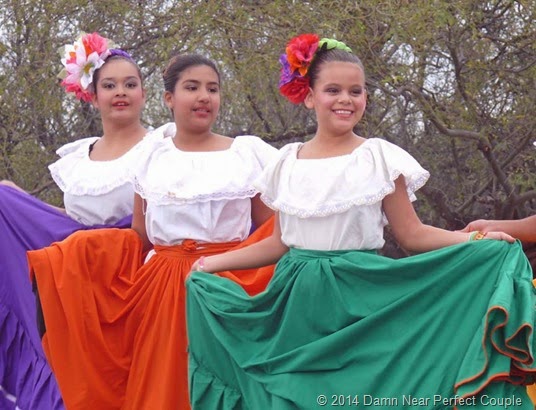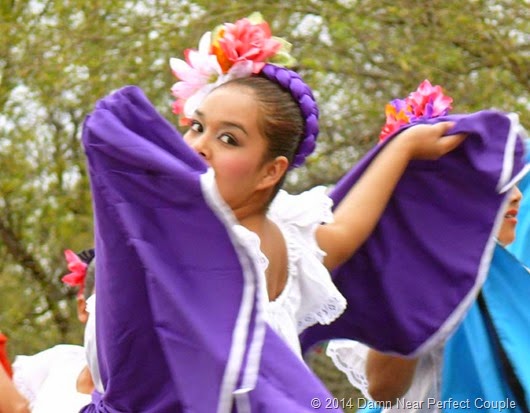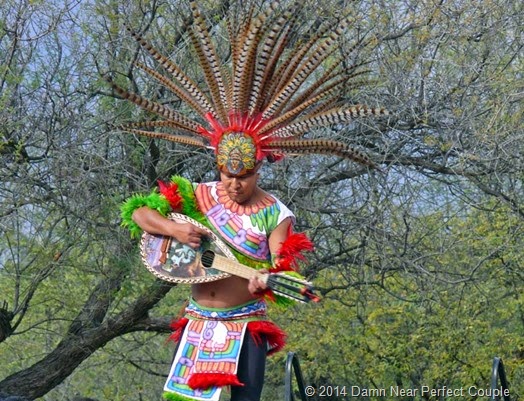Brenda and I are enjoying the holiday season with friends at the Saguaro SKP Park in Benson, AZ. We’ve finished our shopping, mailed the cards and presents, and put up the tree and decorations. Now it’s time to sit back, enjoy the season, and catch up with friends and family.
Most RVers have a small tree – not Brenda! Christmas is her time, and so we haul out the tubs of decorations and lights, put up the 6’ tree, and decorate to Johnny Mathis Christmas songs! One member of our household doesn’t seem impressed by all the decorations. Her look is cat language for “these changes to my house better stop pretty damn soon!”
One member of our household doesn’t seem impressed by all the decorations. Her look is cat language for “these changes to my house better stop pretty damn soon!”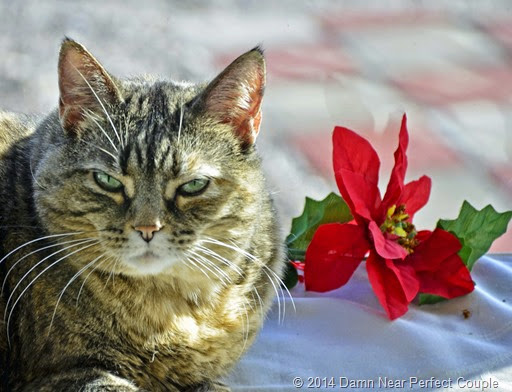 Of course, nothing says “Festive Holiday Season!” like a well-decorated Leg Lamp, placed in the window where our fellow RVers can bask in the glow that only a Major Award can bring:
Of course, nothing says “Festive Holiday Season!” like a well-decorated Leg Lamp, placed in the window where our fellow RVers can bask in the glow that only a Major Award can bring: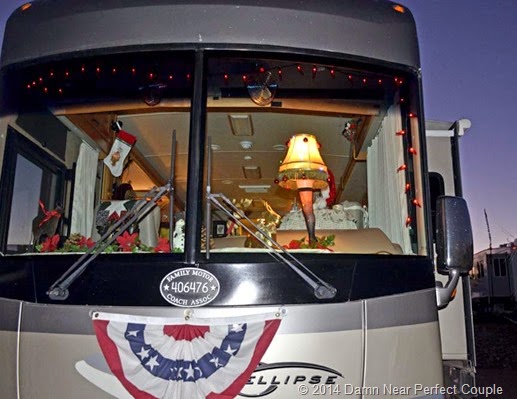
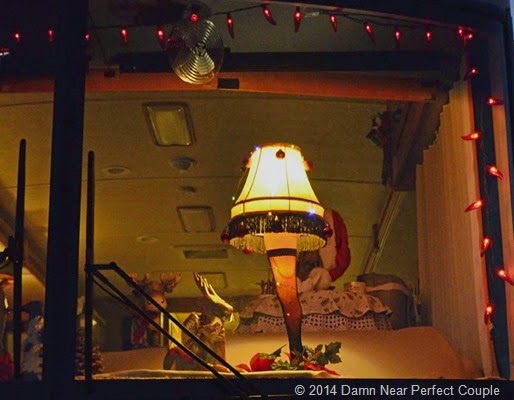 On a serious note – may all your hopes and dreams come true this Christmas season! We hope you all have the opportunity to enjoy being with family and friends, and may you wake up Christmas morning to find everything on your list under the tree!
We both wish you a Merry, Merry, Christmas!
On a serious note – may all your hopes and dreams come true this Christmas season! We hope you all have the opportunity to enjoy being with family and friends, and may you wake up Christmas morning to find everything on your list under the tree!
We both wish you a Merry, Merry, Christmas!
We’ve made quite a transition – from the wet Pacific Northwest to the arid Southwest. We’ve settled in Tucson for a month while our sinuses dry up and our cabinet doors shrink back to where they close easily. We’re at Desert Trails RV Park and are enjoying our stay. The park is located on the west edge of town near Saguaro National Monument and has a nice network of trails that wander through the desert. 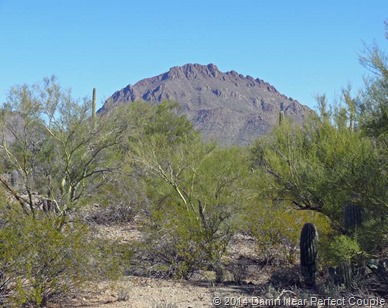 Due to late summer rains, Palo Verde and Mesquite are still green and the area looks more like springtime than winter.
The area is covered with Saguaro, Prickly Pear, and many varieties of Cholla, so it’s wise to watch where you walk if you’re off the trails. I had an unplanned encounter with those fuzzy looking buds on a prickly pear and I am still pulling out those almost invisible, put painful, spines.
Due to late summer rains, Palo Verde and Mesquite are still green and the area looks more like springtime than winter.
The area is covered with Saguaro, Prickly Pear, and many varieties of Cholla, so it’s wise to watch where you walk if you’re off the trails. I had an unplanned encounter with those fuzzy looking buds on a prickly pear and I am still pulling out those almost invisible, put painful, spines.  Park residents have place helpful little signs along the trail that identify the different types of cactus. I came across this barrel cactus, as always leaning toward the south, and learned that barrel cactus signs apparently lean in the same direction:
Park residents have place helpful little signs along the trail that identify the different types of cactus. I came across this barrel cactus, as always leaning toward the south, and learned that barrel cactus signs apparently lean in the same direction: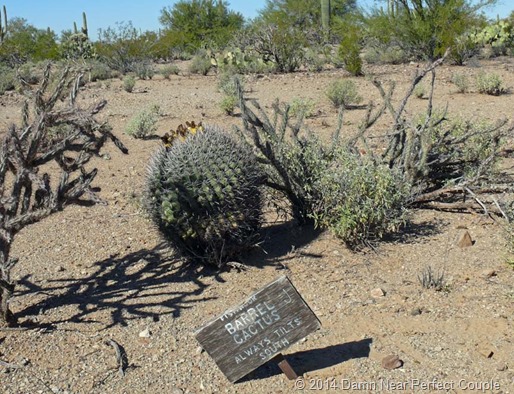 Southern Arizona, like the San Antonio area, has a long history of missionary activity beginning in the 1600s. One of the oldest missions, Tumacocori (Too-muh-kä'-ko-ree), was having their annual festival and so we headed down I-19 with our friends Kirk and Sue to take a look. Originally founded in 1691, the current mission’s construction was started in 1800, but was never completed. Today, you can view the mission restored to the condition it was when abandoned. Left unfinished to reflect the original condition, the exterior still has the holes required by the construction scaffolding. It’s a beautiful mission – some images:
Southern Arizona, like the San Antonio area, has a long history of missionary activity beginning in the 1600s. One of the oldest missions, Tumacocori (Too-muh-kä'-ko-ree), was having their annual festival and so we headed down I-19 with our friends Kirk and Sue to take a look. Originally founded in 1691, the current mission’s construction was started in 1800, but was never completed. Today, you can view the mission restored to the condition it was when abandoned. Left unfinished to reflect the original condition, the exterior still has the holes required by the construction scaffolding. It’s a beautiful mission – some images:



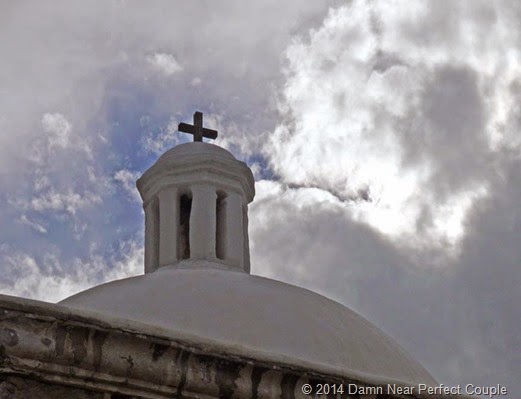
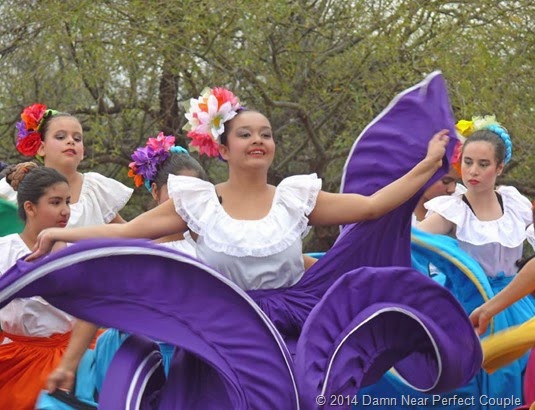
The festival, or fiesta, was in full swing when we arrived. Lots of vendors, but unlike others we’ve visited, this event focused on wildlife, nature, and children. There were free hummingbird feeders, information booths on the area’s national monuments and state parks, and many activities for children. State and Federal park volunteers showed kids how to make adobe bricks, tortillas, and baskets, and best of all, let them take turns at hitting a giant Piñata filled with candy. We especially enjoyed the music and young dancers in their colorful dresses:
There were also Yaqui Indian dancers in beautifully made traditional dress:
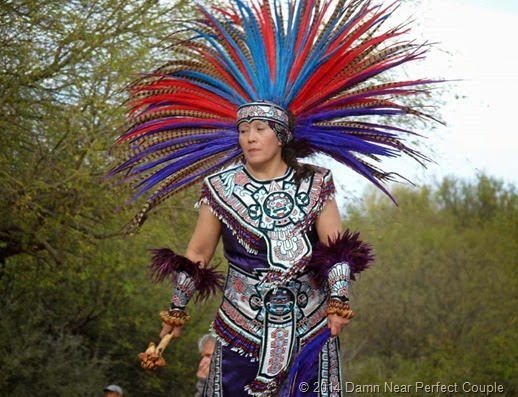 After an enjoyable afternoon here, we drove a few miles north to Tubac, originally a presidio, or fort, with a state historic site. Today the history of the presidio is overshadowed by the over 80 galleries and shops that lure snowbirds to buy high-priced arts and crafts. We wandered around looking, but aside from a bottle of gourmet olive oil didn’t find anything to interest us. I was impressed, though, by the colorful pottery setting next to this Arizona Sycamore tree:
After an enjoyable afternoon here, we drove a few miles north to Tubac, originally a presidio, or fort, with a state historic site. Today the history of the presidio is overshadowed by the over 80 galleries and shops that lure snowbirds to buy high-priced arts and crafts. We wandered around looking, but aside from a bottle of gourmet olive oil didn’t find anything to interest us. I was impressed, though, by the colorful pottery setting next to this Arizona Sycamore tree: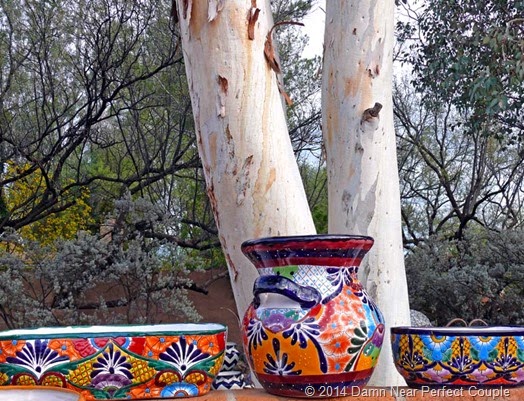 We’re happy to be back in Southern Arizona after five winters in Texas. Tucson was our first home as husband and wife, and being back here brings back so many great memories. We’ll be visiting more places, so check back and see what we’ve been up to!
We’re happy to be back in Southern Arizona after five winters in Texas. Tucson was our first home as husband and wife, and being back here brings back so many great memories. We’ll be visiting more places, so check back and see what we’ve been up to!
I’m not the type who can blog daily….or even weekly, although I try to update our travels at least monthly. I’ve even failed at that, and so here’s what we’ve been doing since our last visit:
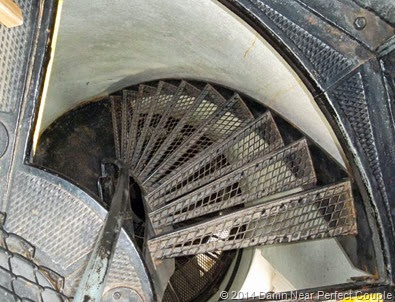 |
| Add caption |
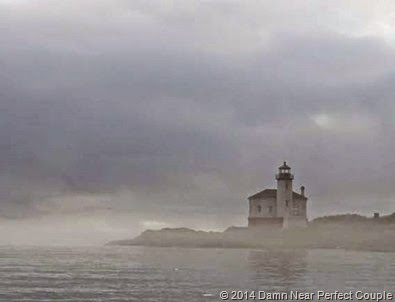 On October 1st, we left Humbug Mountain State Park and drove north 40 miles to Bullards (no, there isn’t an apostrophe) Beach State Park for a month’s stay. We weren’t ready to leave the coast yet, and Julie, the Interpretive Ranger there said she could keep us busy giving a few lighthouse tours until it closed on Columbus Day, along with doing “site maintenance” (more later). We were glad to oblige, since we’d stayed at Bullards before and enjoyed it, and the neat little town of Bandon is just down the road and a favorite of ours. Bullards Beach was a big change from sleepy Humbug Mountain. Here, three loops held over 100, mostly full-hookup sites, and almost all were filled with fisherman since the salmon run was ongoing. We had a nice site (see our volunteer section), with lots of room and privacy and since we were across from the dumpster, had the opportunity to see everyone in the park at one time or another. We started off by working two days of three hour shifts in the lighthouse, a picturesque and popular stop for people visiting the nearby beach. There’s not a lot of history to this lighthouse compared to others along the coast, but it was fun to learn something new. Brenda would stay below in the gift shop while I’d climb the 28 steps to the small light room, where I’d wait for a radio call from her to tell me how many people were waiting for a tour. There wasn’t much to show visitors, just a view through the now-Plexiglas windows overlooking the Coquille River and the surrounding beaches. Our lighthouse duties were cut short when a Pacific storm with 20+ foot waves washed debris up onto the parking lot and resulted in the park manager closing the lighthouse for the season. Although we’d never tried “site maintenance” we found out that it was enjoyable and easy to do. Each morning we’d get our list of campsites, usually between 10
On October 1st, we left Humbug Mountain State Park and drove north 40 miles to Bullards (no, there isn’t an apostrophe) Beach State Park for a month’s stay. We weren’t ready to leave the coast yet, and Julie, the Interpretive Ranger there said she could keep us busy giving a few lighthouse tours until it closed on Columbus Day, along with doing “site maintenance” (more later). We were glad to oblige, since we’d stayed at Bullards before and enjoyed it, and the neat little town of Bandon is just down the road and a favorite of ours. Bullards Beach was a big change from sleepy Humbug Mountain. Here, three loops held over 100, mostly full-hookup sites, and almost all were filled with fisherman since the salmon run was ongoing. We had a nice site (see our volunteer section), with lots of room and privacy and since we were across from the dumpster, had the opportunity to see everyone in the park at one time or another. We started off by working two days of three hour shifts in the lighthouse, a picturesque and popular stop for people visiting the nearby beach. There’s not a lot of history to this lighthouse compared to others along the coast, but it was fun to learn something new. Brenda would stay below in the gift shop while I’d climb the 28 steps to the small light room, where I’d wait for a radio call from her to tell me how many people were waiting for a tour. There wasn’t much to show visitors, just a view through the now-Plexiglas windows overlooking the Coquille River and the surrounding beaches. Our lighthouse duties were cut short when a Pacific storm with 20+ foot waves washed debris up onto the parking lot and resulted in the park manager closing the lighthouse for the season. Although we’d never tried “site maintenance” we found out that it was enjoyable and easy to do. Each morning we’d get our list of campsites, usually between 10 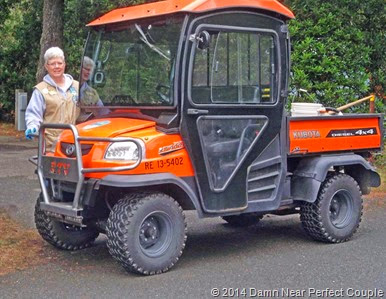 and 15, and off we’d go in a cart loaded with leaf blower, rakes, and trash pickers. At each site, I’d blow the pad clean while Brenda would rake if needed and pick up any trash. We were usually done in an hour or two unless we had to wait for people to leave, and were home for the day in time for lunch and a nap. It was a welcome change from daily lesson preparation and working on craft kits, and we had the chance to get to know a new group of volunteers and park staff.
and 15, and off we’d go in a cart loaded with leaf blower, rakes, and trash pickers. At each site, I’d blow the pad clean while Brenda would rake if needed and pick up any trash. We were usually done in an hour or two unless we had to wait for people to leave, and were home for the day in time for lunch and a nap. It was a welcome change from daily lesson preparation and working on craft kits, and we had the chance to get to know a new group of volunteers and park staff.  Doug and his wife Gloria, our neighbors for a while at Humbug Mountain, were also here. Doug had a boat he used for crabbing (which is at its best this time of year), and on one day he and his visiting daughter hit the mother lode of crabs, laid out on his site before cleaning and freezing. They may look quiet and docile, but as “Bloody Fingers Doug” discovered, don’t be deceived - they’re just waiting for the chance to go out in a blaze of crab glory.
At the end of the month, we packed up, said goodbye, and headed over the mountains to the Southern Willamette Valley. After having some annual motor home maintenance done (I highly recommend Southern Oregon Diesel), we drove south for a stop in Yreka, CA. It’s a small town in a pretty area without much that’s noteworthy except for the views of Mount Shasta that can be seen from the southern edge of town. It already has a sizable amount of snow, and hopefully it will continue to accumulate in this drought-stricken area.
Doug and his wife Gloria, our neighbors for a while at Humbug Mountain, were also here. Doug had a boat he used for crabbing (which is at its best this time of year), and on one day he and his visiting daughter hit the mother lode of crabs, laid out on his site before cleaning and freezing. They may look quiet and docile, but as “Bloody Fingers Doug” discovered, don’t be deceived - they’re just waiting for the chance to go out in a blaze of crab glory.
At the end of the month, we packed up, said goodbye, and headed over the mountains to the Southern Willamette Valley. After having some annual motor home maintenance done (I highly recommend Southern Oregon Diesel), we drove south for a stop in Yreka, CA. It’s a small town in a pretty area without much that’s noteworthy except for the views of Mount Shasta that can be seen from the southern edge of town. It already has a sizable amount of snow, and hopefully it will continue to accumulate in this drought-stricken area.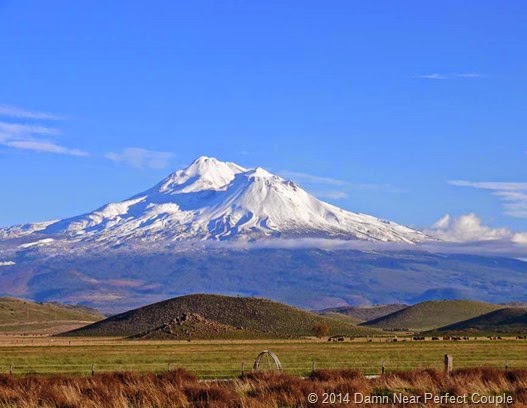 A bit south of Yreka, we left the interstate and headed east over the mountains to Reno. It’s a beautiful drive on two-lane highways, and this time of year the aspen and cottonwood trees provided a wonderful backdrop to the pine forests.
A bit south of Yreka, we left the interstate and headed east over the mountains to Reno. It’s a beautiful drive on two-lane highways, and this time of year the aspen and cottonwood trees provided a wonderful backdrop to the pine forests. 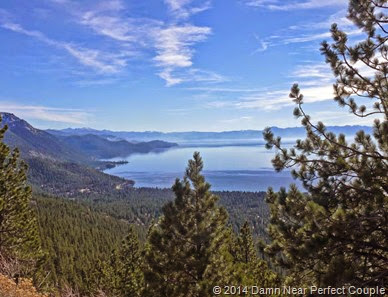 We spent a few days just outside Reno at the Sparks Marina RV Resort, and since we’ve been here many times, didn’t feel the need to explore or take photos. We did however, take a drive to Lake Tahoe’s Incline Village for lunch and a view of the always-serene looking Lake.
On to Las Vegas, where we always stay at Nellis Air Force base. We managed to hit town on the weekend of their annual airshow, and although we didn’t feel like joining the large crowds, we watched the Thunderbirds and other aircraft while sitting in our lawn chairs at our site.
We spent a few days just outside Reno at the Sparks Marina RV Resort, and since we’ve been here many times, didn’t feel the need to explore or take photos. We did however, take a drive to Lake Tahoe’s Incline Village for lunch and a view of the always-serene looking Lake.
On to Las Vegas, where we always stay at Nellis Air Force base. We managed to hit town on the weekend of their annual airshow, and although we didn’t feel like joining the large crowds, we watched the Thunderbirds and other aircraft while sitting in our lawn chairs at our site.
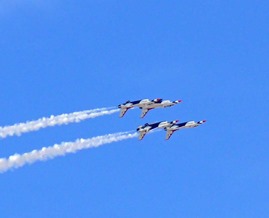
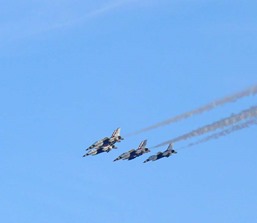
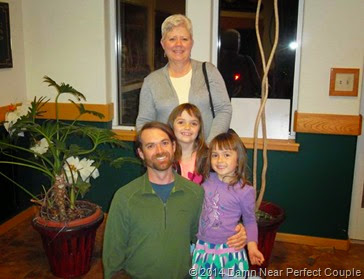 Soon we’ll pack up and head for the Tucson area for the winter. But we’ll miss the Oregon coast and the friends we’ve made. We were fortunate before we left to share an evening with our Interpretive Ranger and good friend Greg and his beautiful daughters Stella and Jada. We had a great evening together – pizza, ice cream, and laughter. What could be better?
We love the desert, but will miss the majesty of the Pacific Ocean, especially during coastal storms. We’ll leave you with some images of a moderate storm we experienced while visiting Yaquina Head near Newport, Oregon:
Soon we’ll pack up and head for the Tucson area for the winter. But we’ll miss the Oregon coast and the friends we’ve made. We were fortunate before we left to share an evening with our Interpretive Ranger and good friend Greg and his beautiful daughters Stella and Jada. We had a great evening together – pizza, ice cream, and laughter. What could be better?
We love the desert, but will miss the majesty of the Pacific Ocean, especially during coastal storms. We’ll leave you with some images of a moderate storm we experienced while visiting Yaquina Head near Newport, Oregon:
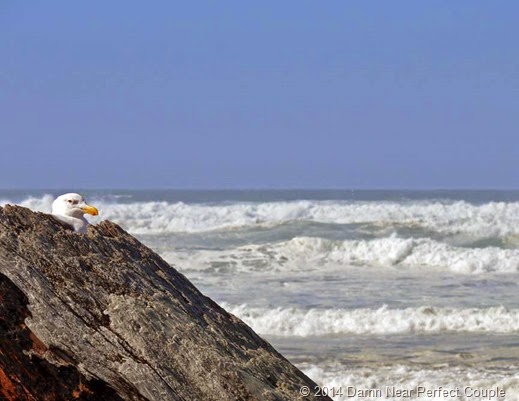
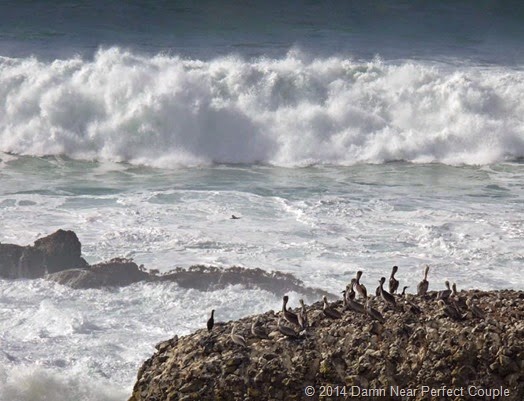
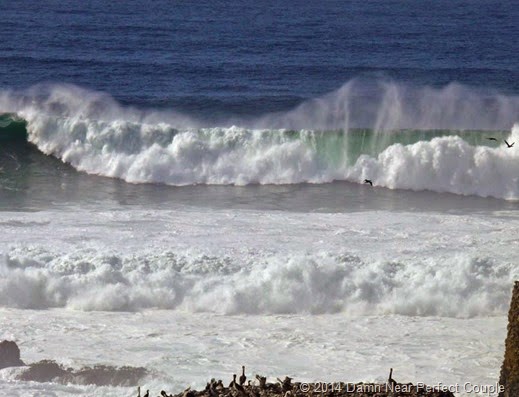
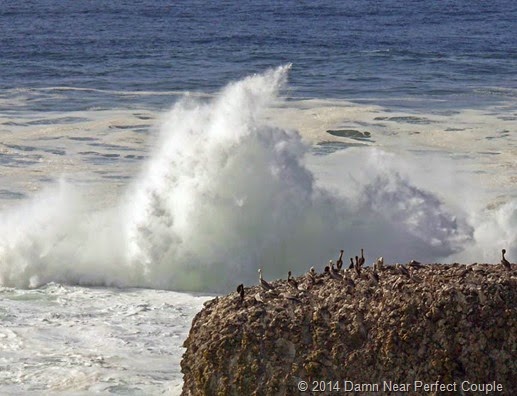 That’s it for now; we’re looking forward to visiting Southern Arizona again after a five-year absence. We’ve already planned adventures, so check back with us!
That’s it for now; we’re looking forward to visiting Southern Arizona again after a five-year absence. We’ve already planned adventures, so check back with us!
One of the first tasks we gave ourselves when settled in at Humbug Mountain this summer was the capture of a salamander for our Junior Ranger’s “Secrets of the Salamanders” class. We’d tell the kids about the many (over 20) varieties of salamanders in Oregon, show them photos, talk about their characteristics, and finish by making a way-cool beaded salamander. But having a live salamander to show the kids worked so well on our last visit here that we wanted to once again capture a sample, keep it in a terrarium, and have it to show the kids. So off into the woods we went, and lo and behold, seemingly waiting for us was a lizardly-looking creature, which we later learned, was a Rough-skinned Newt. A newt, we said, how cool – but about all we knew about newts was the Shakespearian phrase “eye of newt, and toe of frog” from MacBeth. After doing some research we found out that we were holding (EGAD!) Oregon’s deadliest critter!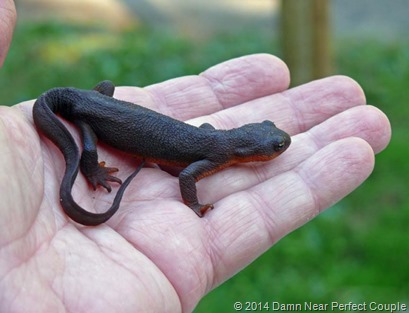 But not to worry, as we learned in our research, holding a Rough-skinned Newt won’t hurt you, and they can’t bite, scratch, or even talk badly about you. But…..the definitive story is this:
In the 60s, three hunters went missing in Oregon. When found, they were all clustered around a campfire, coffee cups in hand, and very dead. Authorities were mystified – there were no wounds or signs of foul play. But there was one thing – a dead Rough-skinned Newt in the coffee pot. Later, a biologist, curious about the event, analyzed a newt and found that it
But not to worry, as we learned in our research, holding a Rough-skinned Newt won’t hurt you, and they can’t bite, scratch, or even talk badly about you. But…..the definitive story is this:
In the 60s, three hunters went missing in Oregon. When found, they were all clustered around a campfire, coffee cups in hand, and very dead. Authorities were mystified – there were no wounds or signs of foul play. But there was one thing – a dead Rough-skinned Newt in the coffee pot. Later, a biologist, curious about the event, analyzed a newt and found that it 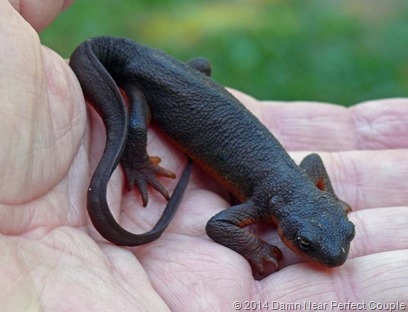 contained a toxin 1000 times more powerful than cyanide; enough toxin to kill at least a dozen people. Apparently the hunters scooped up a pot of stream water not realizing that they had the newt, or perhaps they reheated the coffee that the newt had crawled into. In another Newt-scare, In 1979, a college student that had been drinking swallowed a Rough-skinned Newt on a dare and died within an hour. Here’s more Information.
We realized what a great tool our newt could be in teaching the children how to identify it, why it was dangerous, and that they’d need to keep their dogs or cats away from it. Since our newt was an exotic-looking little creature and we needed a
contained a toxin 1000 times more powerful than cyanide; enough toxin to kill at least a dozen people. Apparently the hunters scooped up a pot of stream water not realizing that they had the newt, or perhaps they reheated the coffee that the newt had crawled into. In another Newt-scare, In 1979, a college student that had been drinking swallowed a Rough-skinned Newt on a dare and died within an hour. Here’s more Information.
We realized what a great tool our newt could be in teaching the children how to identify it, why it was dangerous, and that they’d need to keep their dogs or cats away from it. Since our newt was an exotic-looking little creature and we needed a 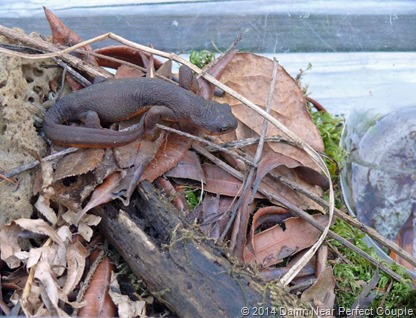 name, we quickly came up with Natasha, a name that fit her well although she never seemed to learn to come when called. Throughout the summer, we’d bring Natasha out of her “condo” (complete with pool) to show the kids, letting her crawl over my hand while they watched, fascinated in her movements. Natasha seemed to enjoy the attention and never went into her threat posture. We fed her worms and any bugs we found, changed her pool water, and kept her in a shady, cool place at our site.
name, we quickly came up with Natasha, a name that fit her well although she never seemed to learn to come when called. Throughout the summer, we’d bring Natasha out of her “condo” (complete with pool) to show the kids, letting her crawl over my hand while they watched, fascinated in her movements. Natasha seemed to enjoy the attention and never went into her threat posture. We fed her worms and any bugs we found, changed her pool water, and kept her in a shady, cool place at our site.
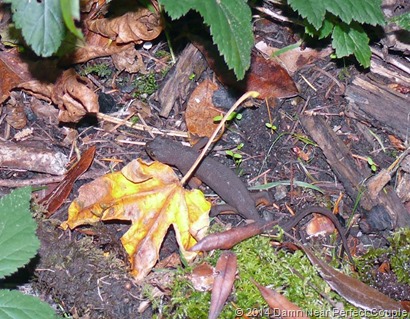 But came the day when we had to return her to the wild. We located the place where we originally found her, thanked her for her service and released her. She looked up at us as if to say “what – no more easy food? And what about my pool? And each day we wonder if we’ll open our door to find Natasha on our step, looking for her condo, worms, and pool. We can only hope.
But came the day when we had to return her to the wild. We located the place where we originally found her, thanked her for her service and released her. She looked up at us as if to say “what – no more easy food? And what about my pool? And each day we wonder if we’ll open our door to find Natasha on our step, looking for her condo, worms, and pool. We can only hope.
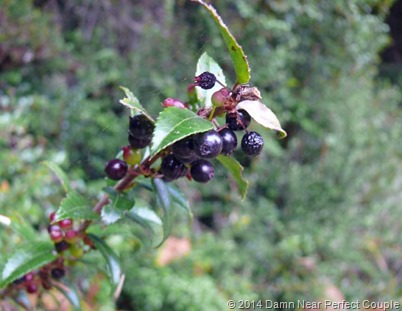 This year we were disappointed by the wild blackberries due to the lack of rain; they were stunted, dried out, and sour. So I was concerned about the huckleberries, but although the bushes at our park were pretty well dried up, the ones nearer the areas with coastal fog were close to normal. Huckleberries are my favorite berry – tart, flavorful,
This year we were disappointed by the wild blackberries due to the lack of rain; they were stunted, dried out, and sour. So I was concerned about the huckleberries, but although the bushes at our park were pretty well dried up, the ones nearer the areas with coastal fog were close to normal. Huckleberries are my favorite berry – tart, flavorful, 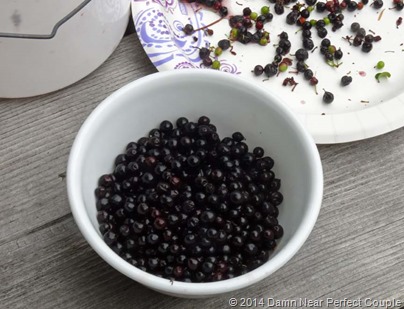 and just the right compliment to pancakes. But picking them is a chore, they’re small and when you strip them off the bush you end up with leaves, unripe berries, and a surprisingly large number of little bitty spiders that seem to live on the berry bush. But although each berry ends up being touched twice (once to pick, once to separate from the trash), it’s worth it. We’ve frozen enough to keep me in Huckleberry pancakes throughout the winter, with some left over for ice cream!
On our last Saturday at Humbug Mountain we volunteered to serve
and just the right compliment to pancakes. But picking them is a chore, they’re small and when you strip them off the bush you end up with leaves, unripe berries, and a surprisingly large number of little bitty spiders that seem to live on the berry bush. But although each berry ends up being touched twice (once to pick, once to separate from the trash), it’s worth it. We’ve frozen enough to keep me in Huckleberry pancakes throughout the winter, with some left over for ice cream!
On our last Saturday at Humbug Mountain we volunteered to serve  as “Beach Captains” for a local organization’s beach clean up day. One of the great things about this area is the quality of the beaches and how people work to keep them pristine. After four hours, we had very little trash collected; mostly ropes and buoys from commercial fisherman, although one person found a small refrigerator door from the Japanese tsunami. We met some great people during the day, while enjoying the sun, the breeze, and the great view.
The next day we made a trip to our favorite view point for seals and sea lions. Simpson’s Reef, located near Charleston, is a gathering place for all four of the Pacific Coast pinnipeds – Harbor Seals, California Sea Lions, Steller Sea Lions, and Northern Elephant Seals. The reef was rocking with the sound of thousands of barks, grunts, and roars – it was magical!
as “Beach Captains” for a local organization’s beach clean up day. One of the great things about this area is the quality of the beaches and how people work to keep them pristine. After four hours, we had very little trash collected; mostly ropes and buoys from commercial fisherman, although one person found a small refrigerator door from the Japanese tsunami. We met some great people during the day, while enjoying the sun, the breeze, and the great view.
The next day we made a trip to our favorite view point for seals and sea lions. Simpson’s Reef, located near Charleston, is a gathering place for all four of the Pacific Coast pinnipeds – Harbor Seals, California Sea Lions, Steller Sea Lions, and Northern Elephant Seals. The reef was rocking with the sound of thousands of barks, grunts, and roars – it was magical!
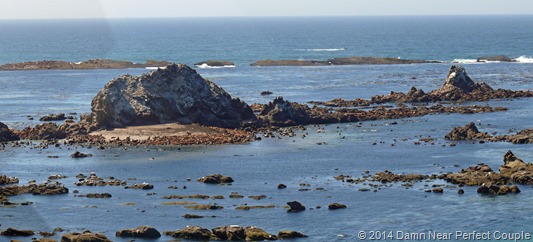 Finally, when we first visited the area in 2007, we took a picture of this sunken boat at Gold Beach. The Mary D. Hume has an interesting history and is on the National Register of Historic Places. She hasn’t fared well over the years, and we wondered if what is left will make it through the winter storms:
Finally, when we first visited the area in 2007, we took a picture of this sunken boat at Gold Beach. The Mary D. Hume has an interesting history and is on the National Register of Historic Places. She hasn’t fared well over the years, and we wondered if what is left will make it through the winter storms:
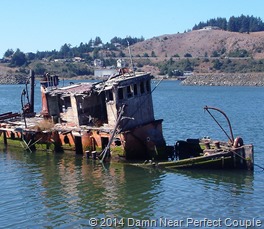
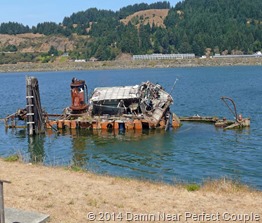 What a wonderful summer we had at Humbug Mountain! The park, the kids, the area, and the staff – our Interpretive ranger, Greg, all-knowing and ever smiling Laura, and rangers Paul, Rick, Deb, Danny, April, Lucas, Michael, and all the other hosts we worked with. We’ll never forget our great times together!
We’ve moved up the road to spend a month at Bullards Beach State Park, where we’ll give lighthouse tours and help in campsite maintenance. Check back and see how we’re doing!
What a wonderful summer we had at Humbug Mountain! The park, the kids, the area, and the staff – our Interpretive ranger, Greg, all-knowing and ever smiling Laura, and rangers Paul, Rick, Deb, Danny, April, Lucas, Michael, and all the other hosts we worked with. We’ll never forget our great times together!
We’ve moved up the road to spend a month at Bullards Beach State Park, where we’ll give lighthouse tours and help in campsite maintenance. Check back and see how we’re doing!
One of the many reasons Brenda and I were excited to return to the Oregon Coast was the seafood; and for Brenda that means CRAB. On our last summer’s visit, we made regular trips to the Mill Casino in North Bend for their weekly seafood buffet. It was paradise – local oysters on the half shell, mussels, shrimp, many varieties of seafood dishes, prime rib……and a huge iced bowl of Dungeness Crab. For the $17 all-you-can eat, it was a bargain that we couldn’t pass on, and apparently we and other crustacean-loving seniors put the buffet out of business. sigh. But to the rescue came our Interpretive Ranger, Greg, who just happens to have a boat….and crab traps! He graciously invited me on a crab excursion in the Coquille River near Bandon, and I, with Brenda’s rabid encouragement, jumped at the chance.
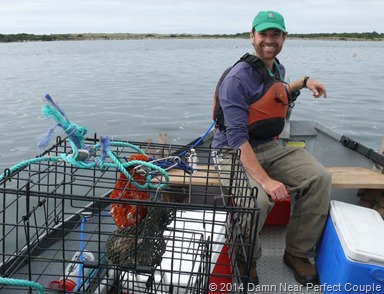 Launching the boat at the peak of high tide (crab are more active when the current is slack), Greg baited the pots with a mixture of old fish, rotten old fish, and decomposing old fish – apparently crab and my last Lab puppy have the same preferences, and we dropped our three traps into the water.
Launching the boat at the peak of high tide (crab are more active when the current is slack), Greg baited the pots with a mixture of old fish, rotten old fish, and decomposing old fish – apparently crab and my last Lab puppy have the same preferences, and we dropped our three traps into the water.
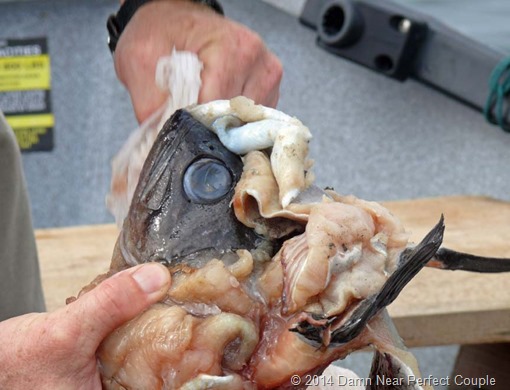 For the next 20 minutes or so, we cruised around in what was unusually calm water and light wind. Finally it was time to pull up the traps and see what we had – like opening a Christmas present, I was excited to see what was in the “box”. And we had crabs! about 8 or nine, all but one undersized or female (you have to throw the females back) .
For the next 20 minutes or so, we cruised around in what was unusually calm water and light wind. Finally it was time to pull up the traps and see what we had – like opening a Christmas present, I was excited to see what was in the “box”. And we had crabs! about 8 or nine, all but one undersized or female (you have to throw the females back) . 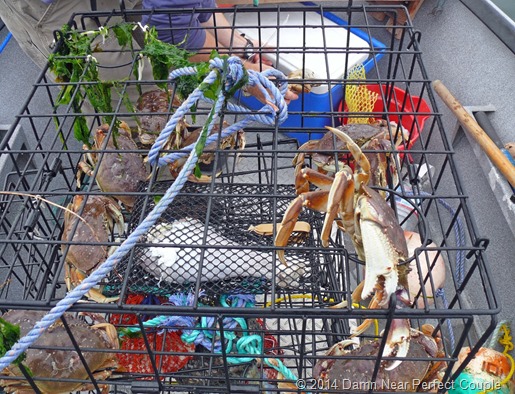 This was truly an educational experience – and I quickly learned three things: 1) Crabs do not want to come out of the trap; 2) their pinchers are like Ginsu knives, and 3) because of 1 & 2, I was in for a painful afternoon. At first, I tried the recommended technique of grabbing them by the rear two legs and holding them that way. Except that I found out that crabs can reach back with their other legs, and with their laser-sharp tips, jab the crap out of your hands . So I tried grabbing the shell from above, and quickly found out that it works as long as the crab doesn’t expect it – but all of these were. But with patience, perseverance and profanities, I managed to sort out the throwbacks from the keepers. And I’m sure my hands will heal in time.
Some of the big guys would grab hold of the trap, look at me with their beady eyes, and dare me to touch them. This guy is giving me the “go ahead, make my day” stare…..
This was truly an educational experience – and I quickly learned three things: 1) Crabs do not want to come out of the trap; 2) their pinchers are like Ginsu knives, and 3) because of 1 & 2, I was in for a painful afternoon. At first, I tried the recommended technique of grabbing them by the rear two legs and holding them that way. Except that I found out that crabs can reach back with their other legs, and with their laser-sharp tips, jab the crap out of your hands . So I tried grabbing the shell from above, and quickly found out that it works as long as the crab doesn’t expect it – but all of these were. But with patience, perseverance and profanities, I managed to sort out the throwbacks from the keepers. And I’m sure my hands will heal in time.
Some of the big guys would grab hold of the trap, look at me with their beady eyes, and dare me to touch them. This guy is giving me the “go ahead, make my day” stare…..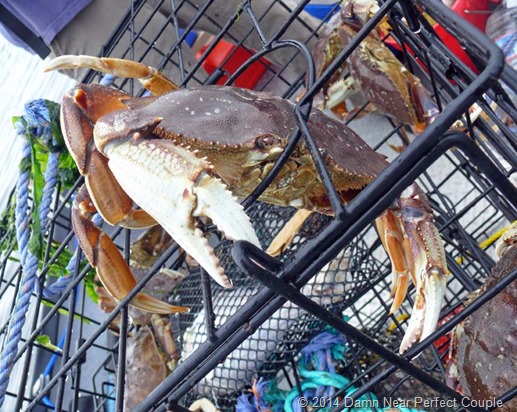 Occasionally we’d hit an area with really large crabs – this guy was our biggest of the day:
Occasionally we’d hit an area with really large crabs – this guy was our biggest of the day:
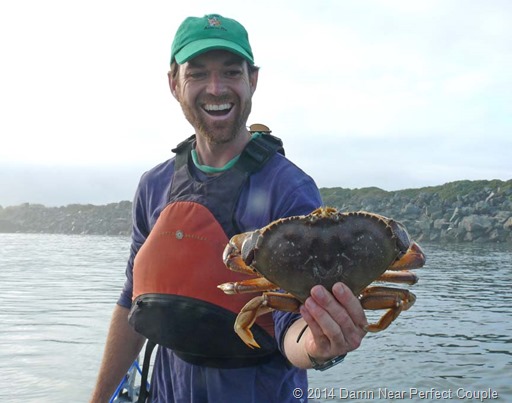 Eventually the tide started moving out, and the pots started coming up empty. The sky had turned hazy with an offshore marine layer and with the Coquille Lighthouse (which we’ll be volunteering at next month) in the background, it made for a spectacular ending of the day.
Eventually the tide started moving out, and the pots started coming up empty. The sky had turned hazy with an offshore marine layer and with the Coquille Lighthouse (which we’ll be volunteering at next month) in the background, it made for a spectacular ending of the day. The next day was payback for my mangled hands. The crabs, kept cool on ice overnight, were ready for the pot. Firing up the gas cooker, they went into the boiling water two at a time, then into an ice water bath to stop the cooking.
The next day was payback for my mangled hands. The crabs, kept cool on ice overnight, were ready for the pot. Firing up the gas cooker, they went into the boiling water two at a time, then into an ice water bath to stop the cooking.
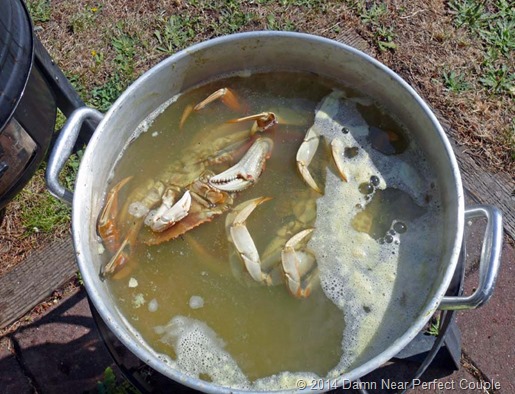
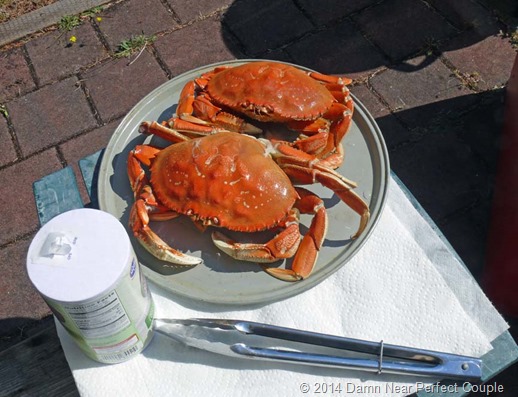 Cleaning the crabs is fairly easy, and once the crab legs and body meat are separated, they went into a bowl of ice:
Cleaning the crabs is fairly easy, and once the crab legs and body meat are separated, they went into a bowl of ice:
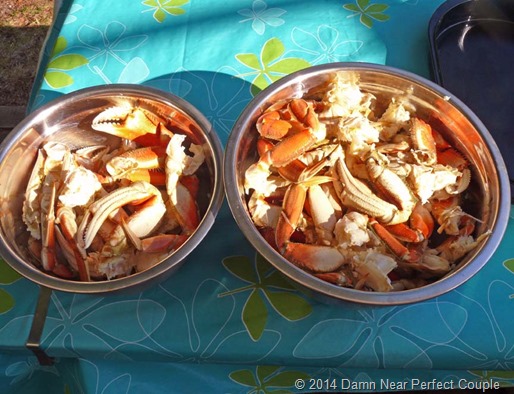 One of the reasons we both love Dungeness Crab is that unlike Blue Crab (we always got tired before we got full), there’s a lot of meat on a Dungeness Crab, and since we had six crabs this time, we were ready for a feast.
One of the reasons we both love Dungeness Crab is that unlike Blue Crab (we always got tired before we got full), there’s a lot of meat on a Dungeness Crab, and since we had six crabs this time, we were ready for a feast.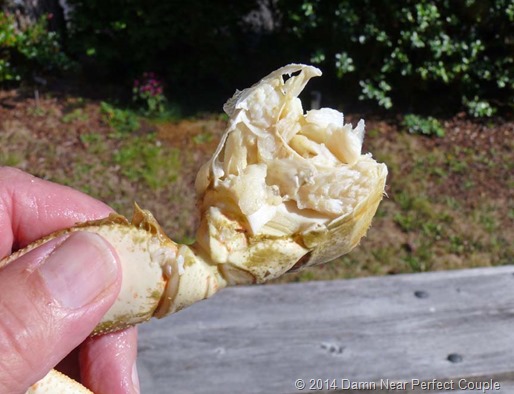 Finally it was time to eat! Fresh crab - check, crusty French Bread - check, cold beer – check, raincoat - check. If you’re sitting close to Brenda, a raincoat is in order, since when she starts tearing into her crab, pieces/parts fly around like snowflakes in an Alaskan snowstorm. But through the storm you can see her big smile, because being crabby is sometimes a happy thing!
Finally it was time to eat! Fresh crab - check, crusty French Bread - check, cold beer – check, raincoat - check. If you’re sitting close to Brenda, a raincoat is in order, since when she starts tearing into her crab, pieces/parts fly around like snowflakes in an Alaskan snowstorm. But through the storm you can see her big smile, because being crabby is sometimes a happy thing!
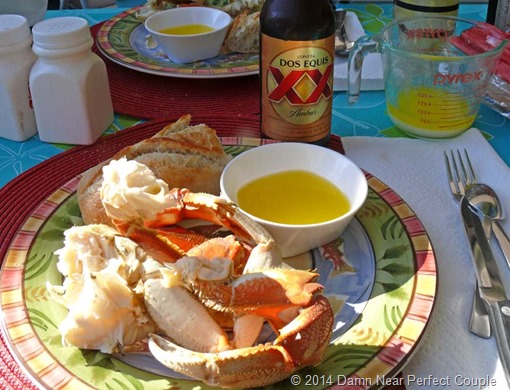 That’s it for now – check back for more of our travel adventures!
That’s it for now – check back for more of our travel adventures!












